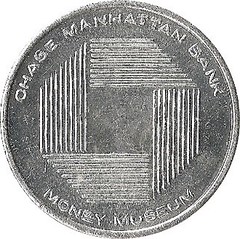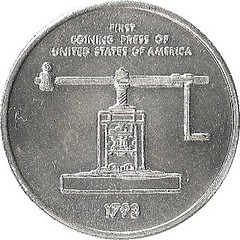
PREV ARTICLE
NEXT ARTICLE
FULL ISSUE
PREV FULL ISSUE
MONEY MUSEUMS IN THE U.S., PART TWOE-Sylum Feature Writer and American Numismatic Biographies author Pete Smith submitted this wonderful compilation of Money Museums in the United States, past and present. Here's the second and final part. An amazing list - while I was at least somewhat familiar with most of these, there are a number I'd missed or forgotten about. Very useful. Have you visited any of the obsolete museums? Please share your experience with us. -Editor
Money Museums in the United States
Nebraska Boy's Town Philamatic Center. Boys Town was first located in the former home of Byron Reed in Omaha, Nebraska. The Philamatic center opened on July 1, 1951. Although the emphasis is on stamps, they also show numismatic material. Mel Stark, curator 1960-1979. Leo J. Eckert, curator 1979-1984, D. O. Barrett, curator. Durham Museum. Omaha, Nebraska. Featuring the Byron Reed Collection. The exhibit was mounted by curator Dr. Larry Lee. [Open] Nevada Bellagio Hotel, Las Vegas. When I visited the Bellagio Hotel in 2005, they had a money museum with an admission charge. I was unwilling to pay the price of admission. Columbus Industries, Inc., Reno. Nevada. announced the opening of a money museum in 1988. They were a coin dealer and auction company. The museum was not mentioned again. Nevada State Museum, Carson City. The museum is in the Carson City Mint building and includes an exhibit of Carson City coinage and some mint equipment. [Open] New Jersey Princeton University Library, Numismatic Collection. Louis West, curator after 1944. Alan Stahl, curator after 2004. New York American Numismatic Society, Manhattan, New York. Located in Audubon Terrace, Broadway and West 155th in 1904. Moved to Fulton and William Street in 2003. Moved again in 2008 to 75 Varick Street. The collection includes an estimated 800,000 objects. [Currently Active] Barnum's American Museum, New York City. Broadway and Ann Street. Owned by P. T. Barnum who acquired Scudder's American Museum in 1841. The Museum was destroyed by fire on July 13, 1865. Chase Manhattan Bank Money Museum, Rockefeller Center, Manhattan, New York. The collection was formed by Farran Zerbe who created temporary exhibits at world's fairs and expositions; the museum was established in 1929, closed in 1973; donated to the Smithsonian Institution. Vernon Brown, curator, retired in 1963. Gene Hessler, curator 1967-1973. Museum of American Finance, 48 Wall Street, Manhattan. Affiliated with the Smithsonian Institution. Exhibits include stocks and bonds but do not include coins or paper money. The building was damaged by flooding in 2018 but the exhibits survived. New-York Historical Society. 170 Central Park West, New York City. Founded in 1804, they claim to be New York's oldest museum. That is a statement to which the Tammany Society Museum might take exception. They acquired the John C. Kunze collection from his widow in 1818. A few years later, the collection was stolen, leaving only the empty cabinet. Recently, in 2013, they had the 1933 Double Eagle on display there. {Currently Active] Riley's Fifth Ward Museum Hotel, New York City. 94 Broadway. Formed by Thomas Tiley. Opened in 1826. The collection was sold at auction in 1864. Tammany Society Museum, New York City. Situated in the Exchange building in 1793. Collection formed by Gardner Baker. It included several hundred coins and medals. On April 20, 1796, a glass case was broken and silver coins were taken, the second theft from the museum. This made Baker the first victim of a numismatic theft in America. [Closed] North Carolina Mint Museum, Charlotte, North Carolina. Despite its name, this is an art museum without numismatic exhibits. Ohio Federal Reserve Bank of Cleveland, Learning Center and Money Museum, Superior and East Sixth Street, Cleveland, Ohio. Closed September 11, 2001; reopened on January 3, 2005. [Currently Active] Western Museum, Cincinnati. Opened in 1820 as a natural science museum. It included coins on exhibit. [Closed] Pennsylvania American Philosophical Society, American Museum. Pierre Eugene Du Simitiere was owner and curator 1776 to 1781. After his 1784 death, the contents of the museum were sold by a 1785 broadside in what may be the first American auction of a coin collection. First Bank of the United States, Philadelphia. The building is undergoing a 22.2 million dollar renovation project. It is scheduled to reopen as a money museum in 2026.
Independence National Historical Park. Congress Hall. Frank Stewart transferred the
Peale's Philadelphia Museum, Philadelphia. Established by Charles Willson Peale. Situated on the second floor of Independence Hall in 1802. The Peale family sold the museum in 1849. [Closed] Philadelphia Mint, Mint Cabinet. Adam Eckfeldt established the Mint cabinet in 1838, setting aside coinage returned to the Mint and restriking coins missing from the collection. The Mint created an exhibit with 7000 coins and 2000 medals for the Columbian Exposition. The cases were returned to Philadelphia and installed at the Mint. William Ewing DuBois, curator 1838-1881. Robert A. McClure, curator 1881-1902. T. Louis Comparette, curator 1905-1922. In 1923 the Mint Cabinet was transferred to Washington D.C. and the National Numismatic Collection. [Closed] The Fourth Philadelphia Mint has a small exhibit area at the mezzanine level. The lobby includes the Tiffany mosaics from the Third Philadelphia Mint. The Mint has unfortunate errors interpreting the history of the Mint. Pittsburgh, Carnegie Museum. They had, at one time, more than 200,000 coins including the Clapp large cents. William W. Woodside, curator. Tennessee Union Planters National Bank Money Museum, 100 North Main, Memphis, Tennessee. Opened May 1, 1969. Featuring the collection of P.(owell) B.(inford) Trotter. Helen Williams, curator. Virginia Federal Reserve Bank of Richmond Money Museum. Permanently closed in Spring of 2023. Wisconsin Fred W. Harris Money Museum, Wisconsin Dells, Wisconsin. Described as the world's largest portable money museum. Exhibited in various forms in the 1930's, it was described as more diverse than the Chase Bank Museum. Reverend Harris died in 1938. His collection was sold at auction by Bolender in 1940. [Closed]
To read the earlier E-Sylum articles, see:
Wayne Homren, Editor The Numismatic Bibliomania Society is a non-profit organization promoting numismatic literature. See our web site at coinbooks.org. To submit items for publication in The E-Sylum, write to the Editor at this address: whomren@gmail.com To subscribe go to: https://my.binhost.com/lists/listinfo/esylum All Rights Reserved. NBS Home Page Contact the NBS webmaster 
|


